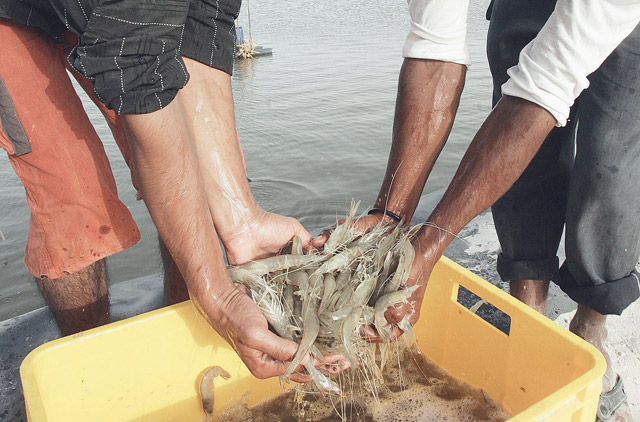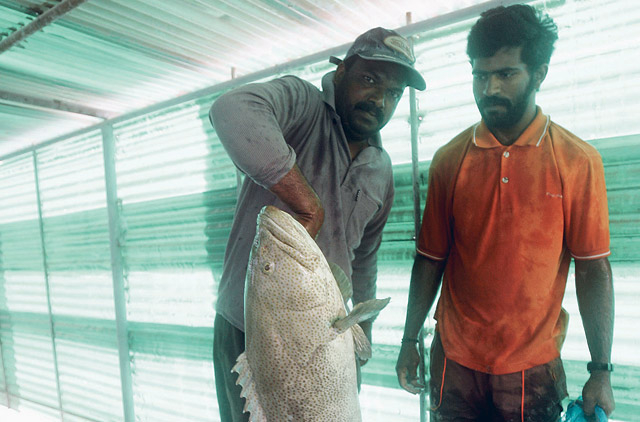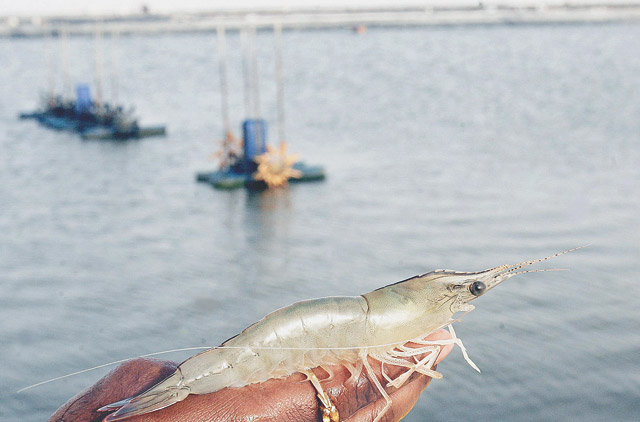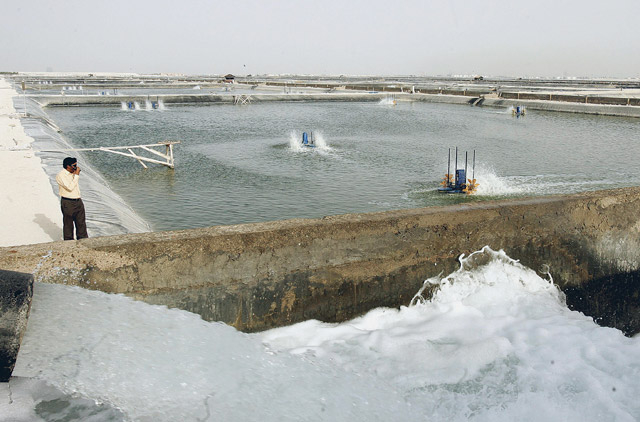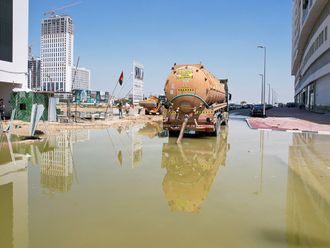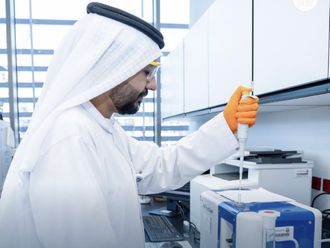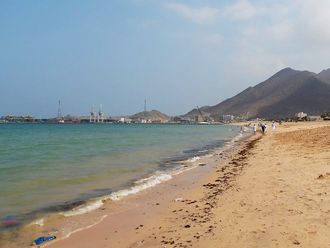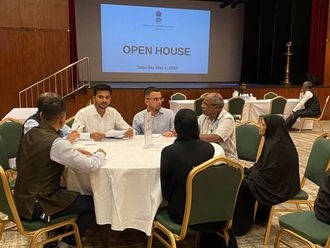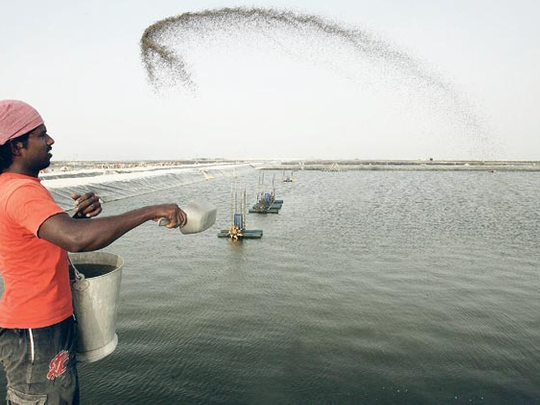
Abu Dhabi: A large number of sea birds flying around the ponds in an island, trying to prey on thousands of shrimps get disappointed most of the time.
"The birds — mostly seagulls, cranes and crows- cannot catch the healthy shrimps as they are ‘bottom dwellers'," says the manager of the shrimp farm, situated on 84 hectares of land on Barmid Island (behind Reem Island), about a 15-minute drive (and a five-minute boat ride) away from Abu Dhabi city.
Most of these ‘bottom dwellers' would be walking or crawling on the floor of the two-metre deep pond with their ‘walking legs', [They have separate legs for swimming], said Dr Gopakumar, Manager and Consultant, Al Jaraf Fisheries, PAL Group of Companies in Abu Dhabi. They swim to the surface only at night, he added.
Cranes that have large beaks may be able to catch some of the weak shrimps that may come up, Gopakumar said. Compared to inland areas, fewer birds are seen in the islands, especially in a desert environment, he said. "Still, we have installed a device to scare the birds — a rotating wheel."
The private island has 64 hectares of water spread area (of man made ponds) for shrimp farming.
The farming begins with the catching of mother shrimps (also called brood stock) from the wild (sea) and testing to ensure they are free from any infection, the manager said.
"We maintain the Specific Pathogen Free [SPF] mother shrimps, due to bio-security reasons. Then the shrimps are acclimatised to our pond conditions and special feeds are given for maturing the eggs," he explained.
Tiger shrimps are bigger in size and the pond-reared mother tiger shrimps grow up to 100 to 120 grams. White mother shrimps weigh 25 to 35 grams, which is used for spawning.
A white mother shrimp can produce 100,000 to 300,000 eggs whereas mother tiger shrimps can lay 500,000 to one million in a single breeding, depending on their size.
"We usually keep them for six to ten spawnings. They will breed until death but prolonged spawning reduces the efficiency and viability of eggs," the manager said.
For quicker maturation and spawning of eggs, healthy females are collected and their one eye is removed under a technique called Eye Stalk Ablation. Once the eye is removed, they start laying eggs every four days, making make breeding process faster.
The breeding [in tanks in hatchery] takes 15 to 20 days after spawning, and then comes the next stage — eggs, larval stages and post larval stages in which baby shrimps around 15 to 20 days old are finally stocked in the ponds, Gopakumar explained.
There are 38 one-hectare ponds, 18 half-hectare ponds and a two hectare pond in the farm. A one-hectare pond can keep 300,000 to 500,000 shrimps. In intensive culture, a maximum of one million shrimps are kept in a one-hectare pond.
"But if there are more shrimps, you have to provide oxygen to the shrimps artificially." A motor device called paddle wheel aerators fixed on the water surface serve that purpose.
When shrimps grow up, their number reduces because the survival rate is 75 per cent. But some ponds have 80 per cent survival rate. A 60 per cent survival is considered a good crop, he said.
The usual catching size is 30-35 grams [of growth], depending on market demand. But an early harvesting at the size between 15 to 20 grams is highly profitable.
"Expenses on feed and other arrangements are less because the crop duration is short and during the early days of its life cycle, the growth is faster", he explained.
After four to five months, you can harvest a total bio mass of five to eight tonnes from each one hectare pond, Gopakumar said.
Now 50 tonnes are ready for market. Winter is better time to eat shrimps because they are hot, he said.
Facility eyes untapped domestic demand
It is surprising to learn from Dr Gopakumar that, although fresh shrimps are a favourite dish of UAE residents, with an estimated daily demand of 11 tonnes across the country (frozen shrimps have a different demand), no farm is commercially producing shrimps to meet it.
"The available live shrimps in the market are at least one or two days old. They are dipped with preservatives like ‘meta bisulphate' [a bleaching agent whose over use can cause problems in stomach] to increase shelf life of the product".
Most of the shrimps are imported from neighbouring Gulf countries such as Saudi Arabia and Oman, and the rest are from India, Pakistan and Bangladesh , which could be older than one or two days, he said.
"There are several small shrimp farms in the UAE producing for private use of the owners only. UAE residents are deprived of the availability of live shrimps in the market because the country has not explored its potential, despite the availability of enough land close to the sea water, he said.
"Ours is the first farm producing the shrimps to meet the domestic demand", the manager claims.
In order to meet this demand [daily demand of 1-1.5 tonnes in Abu Dhabi and 7 to 10 tonnes in other emirates], production should be increased by starting new farms in the UAE, he says.
Al Jaraf Fisheries can provide technical consultancy to the entrepreneur interested in this fields and can also provide baby shrimps which is the most difficult part for a new investor.
Shrimp farming is a very lucrative business since the returns are very fast, with one yield taking a maximum of six months, said the manager.
"We have another farm of a 24-hectare water spread area in Al Bahia in Abu Dhabi", he said.
The biggest shrimp ever caught
The biggest shrimp ever caught in the world was a 435-gram Tiger shrimp [caught from Mumbai waters in India], said Dr Gopakumar.
The tiger prawn is being kept as a specimen [not in live condition] in the museum in the Central Marine Fisheries Research Institute in Kochi in India, he said.
Figures
-The farm has the capacity to produce 1.5 to 2 tonnes of fresh/live shrimps a day
-50 metric tonnes shrimps are ready for supply to the UAE
-On an average 75 per cent survival rate of shrimps,
-300,000-500,000 baby shrimps in one hector pond.
Outlook: The biggest shrimp ever caught
The biggest shrimp ever caught in the world was a 435 grams Tiger shrimp [caught from Mumbai waters in India], said Dr. Gopakumar. The tiger prawn is being kept as a specimen [not in live condition] in the museum in the Central Marine Fisheries Research Institute in Kochi in India, he said.


